Serendipity isn’t something I encounter too frequently while watching Hindi cinema. More often than not, it’s the other way round: I watch a film because I liked the cast, or because the story sounds appealing, or (and this happens with appalling frequency) because the music is wonderful. That I should watch a film about which I know next to nothing—on a whim, so to say—and find that it’s not just watchable but actually quite enjoyable is something to be grateful about. Which is why this review. Seriously speaking, I hadn’t expected much of Parivaar (the name itself conjures up one of those extremely melodramatic social dramas AVM used to specialise in).
Worse, I had my memories (I wish I could rid myself of them) of having watched the utterly execrable Nanda-Jeetendra starrer Parivaar, one of the worst films from the 60s I’ve ever wasted three hours upon. But, back to this Parivaar, which brought a smile of pleased anticipation to my face as soon as the credits began to roll. Directed by Asit Sen and produced by Bimal Roy, Parivaar is set completely within the large haveli of the Choudhary brothers, where all of them, with the exception of one brother, live as a joint family. Over the first hour or so of the film, we are introduced to these men, their families, and their servants. 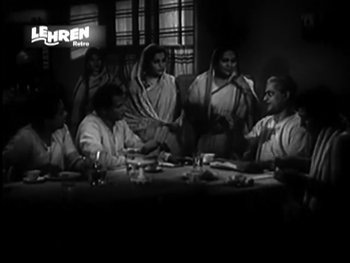 The eldest of the brothers is Mahesh (Bipin Gupta), though he’s only ever referred to as bade bhaiya. Bade bhaiya is the one who is ostensibly in charge of overseeing the family’s land and other large assets, though he seems to spend most of his time playing chess with various nephews.
The eldest of the brothers is Mahesh (Bipin Gupta), though he’s only ever referred to as bade bhaiya. Bade bhaiya is the one who is ostensibly in charge of overseeing the family’s land and other large assets, though he seems to spend most of his time playing chess with various nephews.
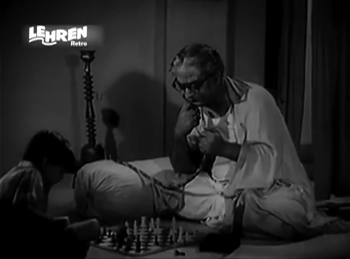 Badi bhabhi (we never do get to hear her name; Durga Khote) is a sweet, genial old lady who governs the household with a velvet fist in a velvet glove: she’s the soul of innocent amiability.
Badi bhabhi (we never do get to hear her name; Durga Khote) is a sweet, genial old lady who governs the household with a velvet fist in a velvet glove: she’s the soul of innocent amiability.
 The majhle bhaiya, the ‘middle brother’ (P Jairaj) is Ramesh, who’s a lawyer. Ramesh is so completely engrossed in his work that even the time he spends at home is devoted mostly to reading briefs and preparing his cases. He’s such an unabashed workaholic that even his wife, everybody’s majhle bhabhi (Usha Kiron) has now reconciled herself to having to take second place to her husband’s work. She’s very cheerful, keeps pulling his leg about it, and is—as emerges from her interactions with the others in the family—a strong-willed, decisive and imaginative woman, the go-getter among the women of the family.
The majhle bhaiya, the ‘middle brother’ (P Jairaj) is Ramesh, who’s a lawyer. Ramesh is so completely engrossed in his work that even the time he spends at home is devoted mostly to reading briefs and preparing his cases. He’s such an unabashed workaholic that even his wife, everybody’s majhle bhabhi (Usha Kiron) has now reconciled herself to having to take second place to her husband’s work. She’s very cheerful, keeps pulling his leg about it, and is—as emerges from her interactions with the others in the family—a strong-willed, decisive and imaginative woman, the go-getter among the women of the family.
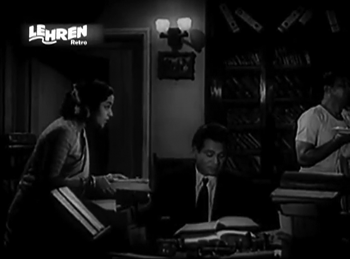 The third brother, Ganesh (Anwar Hussain) doesn’t appear on the scene until nearly an hour of the story is past—because Ganesh, along with his wife Malti (Kumud), lives in Banaras with two of their young children. Ganesh is an engineer, and his work requires him to live in Banaras. However, he and his wife have decided that their eldest son Kamal is best educated in their hometown, so Kamal stays with his uncles, aunts and assorted cousins in the Choudhary haveli. Majhli bhabhi, in particular, dotes upon Kamal, treating him almost as her own child—he even sleeps in her room.
The third brother, Ganesh (Anwar Hussain) doesn’t appear on the scene until nearly an hour of the story is past—because Ganesh, along with his wife Malti (Kumud), lives in Banaras with two of their young children. Ganesh is an engineer, and his work requires him to live in Banaras. However, he and his wife have decided that their eldest son Kamal is best educated in their hometown, so Kamal stays with his uncles, aunts and assorted cousins in the Choudhary haveli. Majhli bhabhi, in particular, dotes upon Kamal, treating him almost as her own child—he even sleeps in her room.
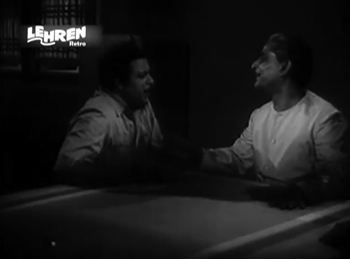 The fourth brother is Dinesh (Sajjan), who’s a doctor. Dinesh is one of those really enthusiastic doctors, constantly pestering his family about minding their health. When we first see him, for instance, he’s getting ready to leave for work, while supervising his wife Jaishree (Kamal) skipping. He tells Jaishree that she needs to skip at least 200 times a day, in order to balance out all the calories she consumes. Not something that Jaishree is overly keen on.
The fourth brother is Dinesh (Sajjan), who’s a doctor. Dinesh is one of those really enthusiastic doctors, constantly pestering his family about minding their health. When we first see him, for instance, he’s getting ready to leave for work, while supervising his wife Jaishree (Kamal) skipping. He tells Jaishree that she needs to skip at least 200 times a day, in order to balance out all the calories she consumes. Not something that Jaishree is overly keen on.
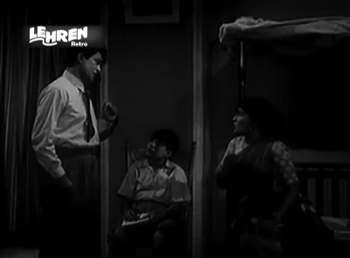 Dinesh doesn’t let the rest of his family alone, either; he brings home a weighing scale and records everybody’s weight so he can monitor their diet. And when the family hosts a large dinner, he goes about putting potassium permanganate in the wash water. Dinesh and Jaishree have one son, little Raju, who is the favourite of bade bhaiya and badi bhabhi—the former loves to play chess with Raju.
Dinesh doesn’t let the rest of his family alone, either; he brings home a weighing scale and records everybody’s weight so he can monitor their diet. And when the family hosts a large dinner, he goes about putting potassium permanganate in the wash water. Dinesh and Jaishree have one son, little Raju, who is the favourite of bade bhaiya and badi bhabhi—the former loves to play chess with Raju.
Last of all, and youngest of the five brothers, is Suresh (Ashim Kumar), who is a musician. He has recently got married, to the equally musically-inclined Manju (Sabita Chatterjee), whom he met at a music-and-dance conference. Their shared love for music and dance means that Suresh and Manju spend much of their time ensconced in their room, doing riyaaz.
 Then, there are the servants. The major domo of the house is Madho (Agha, in one of the most delightful roles I’ve seen him in). Madho is a perpetually harassed, pulled-in-many-directions butler cum general dogsbody cum everything else: just about everybody in the household is telling him to do this or do that every waking moment. This ends up making Madho run about like a headless chicken half the time, but it also brings home to him the fact that this household does rely quite heavily on him. (Not, thankfully, a situation he exploits—more on this later).
Then, there are the servants. The major domo of the house is Madho (Agha, in one of the most delightful roles I’ve seen him in). Madho is a perpetually harassed, pulled-in-many-directions butler cum general dogsbody cum everything else: just about everybody in the household is telling him to do this or do that every waking moment. This ends up making Madho run about like a headless chicken half the time, but it also brings home to him the fact that this household does rely quite heavily on him. (Not, thankfully, a situation he exploits—more on this later).
And, last of all, the maharaj or cook (Dhumal). This man is a constant braggart, boasting of everything from his ear for music (from having worked 10 years at a famous ustad’s house) to his fluency in English (from having worked 10 years at an Englishman’s house). All of which, even to the more gullible members of the household, are obvious signs of wishful thinking.
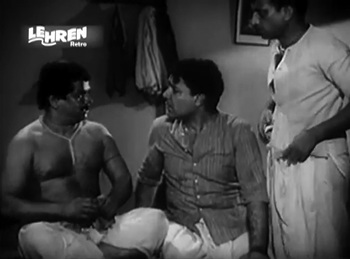 Those are the characters. And the story? Well, not really very much. In fact, the plot itself begins developing only about midway through the film. The first hour or so is spent in the mise en place, so to say; in acquainting us with the people in this story (a considerable task in itself, since there are so many of them). Then comes the incident which changes things and puts in motion a chain of events that will shake up the Choudhary parivaar: the janeyu ceremony for Ganesh’s son Kamal, who will soon be 13. For the occasion, Ganesh, his wife Malti and their two other children also come home for a few days.
Those are the characters. And the story? Well, not really very much. In fact, the plot itself begins developing only about midway through the film. The first hour or so is spent in the mise en place, so to say; in acquainting us with the people in this story (a considerable task in itself, since there are so many of them). Then comes the incident which changes things and puts in motion a chain of events that will shake up the Choudhary parivaar: the janeyu ceremony for Ganesh’s son Kamal, who will soon be 13. For the occasion, Ganesh, his wife Malti and their two other children also come home for a few days.
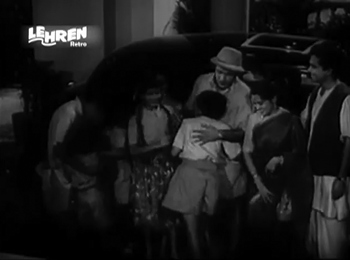 The entire household swings into action to prepare for the feast; all the brothers invite their guests, and the house is very busy on the evening of the function. Madho is being ordered around to do this and that; Dinesh is scurrying around, making sure everything is hygienic, dusting bleach here, sprinkling potassium permanganate there. Bade bhaiya, having done his duty by greeting the guests and participating in the ceremony, has retreated to his own room with Raju, where he’s teaching the child (who’s fallen asleep) chess. Ramesh, the lawyer, is in deep conversation with his father-in-law, telling him all about mortgage law.
The entire household swings into action to prepare for the feast; all the brothers invite their guests, and the house is very busy on the evening of the function. Madho is being ordered around to do this and that; Dinesh is scurrying around, making sure everything is hygienic, dusting bleach here, sprinkling potassium permanganate there. Bade bhaiya, having done his duty by greeting the guests and participating in the ceremony, has retreated to his own room with Raju, where he’s teaching the child (who’s fallen asleep) chess. Ramesh, the lawyer, is in deep conversation with his father-in-law, telling him all about mortgage law.
When Madho, who’s been sent by badi bhabhi to ask if dinner can be laid for the guests, comes, Ramesh tells him to get lost. He’s busy, and so are his guests; can’t Madho see? And Ganesh, who’s a glutton of the first order and has been feeling very hungry, has gotten himself a thali load of goodies and hidden himself in his room, where he’s stuffing his face.  When Suresh—whose equally musically-minded friends are now tuning up and indulging in some singing—is asked if dinner should be laid, he refuses. They’re only just getting into the rhythm of things here; breaking off for dinner will ruin everything. It’s only 11 now, anyway; still plenty of time. And as for the problem of guests having to then go home: why, the family has three cars. Everybody will be dropped home. No worries.
When Suresh—whose equally musically-minded friends are now tuning up and indulging in some singing—is asked if dinner should be laid, he refuses. They’re only just getting into the rhythm of things here; breaking off for dinner will ruin everything. It’s only 11 now, anyway; still plenty of time. And as for the problem of guests having to then go home: why, the family has three cars. Everybody will be dropped home. No worries.
Which basically means that Madho has to go back to the kitchen, frustrated. En route, he overhears one guest telling another that since it’s so late and their hosts show no signs of feeding them, it’s perhaps advisable to go. This guest is already pretty disgusted, and Madho realises that unless something is done quickly, the family is in danger of antagonising a lot of people. Or at least getting talked about behind their backs. The brothers are either oblivious or nowhere to be found; so Madho rushes off to the kitchen and informs badi bhabhi and majhli bhabhi. And it is thanks to these women—who immediately take control—that dinner is served and the situation salvaged.
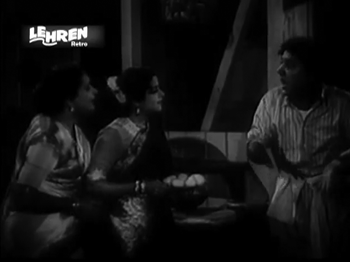 The next morning, the brothers are sitting happily at breakfast, joking and laughing and congratulating themselves on what a success the previous day’s function has been. How happy the guests were. How well everything went. What a good team we are. Like the five Pandavas, so the Choudhary brothers. “All for one, and one for all!” proclaims Ganesh, and all the others join in. There’s much cheering and self-congratulation.
The next morning, the brothers are sitting happily at breakfast, joking and laughing and congratulating themselves on what a success the previous day’s function has been. How happy the guests were. How well everything went. What a good team we are. Like the five Pandavas, so the Choudhary brothers. “All for one, and one for all!” proclaims Ganesh, and all the others join in. There’s much cheering and self-congratulation.
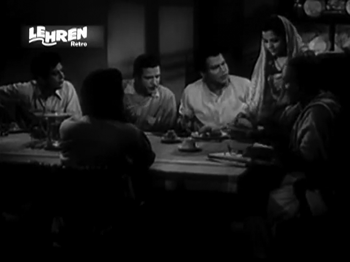 This doesn’t escape the notice of the bahus of the household. Oh, the irony of it! That their men should think it’s because of them that all is well, and peace, harmony, and love rule this household. Majhli bhabhi, in particular, realises that these men are labouring under a delusion: they think it’s because of their brotherly love for each other that the family is so close-knit. What they don’t realise is that it’s because of their wives—if their wives were the quarrelsome, petty, self-serving type, the family would’ve split up and gone its separate ways long, long ago.
This doesn’t escape the notice of the bahus of the household. Oh, the irony of it! That their men should think it’s because of them that all is well, and peace, harmony, and love rule this household. Majhli bhabhi, in particular, realises that these men are labouring under a delusion: they think it’s because of their brotherly love for each other that the family is so close-knit. What they don’t realise is that it’s because of their wives—if their wives were the quarrelsome, petty, self-serving type, the family would’ve split up and gone its separate ways long, long ago.
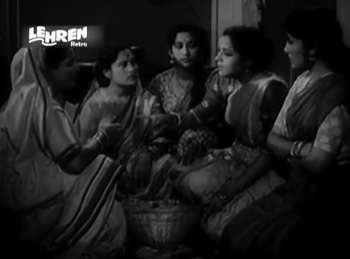 Majhli bhabhi therefore calls for a meeting. The maharaj, Madho and the maid are expelled from the kitchen, the doors are closed, and the five bahus go into a huddle. The four younger bahus are all for teaching their men a lesson; badi bhabhi, who’s far too sweet for her own good (and who has, after all, brought up her brothers-in-law almost like her own children and has a maternal affection for them) doesn’t like the idea.
Majhli bhabhi therefore calls for a meeting. The maharaj, Madho and the maid are expelled from the kitchen, the doors are closed, and the five bahus go into a huddle. The four younger bahus are all for teaching their men a lesson; badi bhabhi, who’s far too sweet for her own good (and who has, after all, brought up her brothers-in-law almost like her own children and has a maternal affection for them) doesn’t like the idea.
She’s hushed up, however, and the women start concocting a plan. They will pretend to fall apart. They will pick quarrels, back-bite, put on a show of bad blood—all to bring home to their husbands the fact that it’s the women who are the glue in this household, not the men.
Will their plan succeed? Will there be pitfalls along the way? Will things spiral out of control?
Like most other Bimal Roy Productions—Sujata, Prem Patra, Parakh among them—Parivaar is one of those films about everyday people, and the everyday problems they face. The small joys that make up their lives. This isn’t life in Technicolor, so to say: it’s simple, perhaps even a little mundane, not the high adrenaline, exciting romance+drama+adventure+mystery+comedy cocktail that goes into most Hindi films. Comfortable, gentle, easy to relate to.
What I liked about this film:
The feel-good nature of the entire film. Each of these characters is easy to relate to, neither too excessively sweet and good, nor bad to the point of villainy. There’s genuine affection here, but also impatience. Deep love, but not of the type which allows the loved one to ride roughshod over the one giving the love and affection. Tolerance, but not doormat-like behaviour. And vice-versa: with a mind of one’s own, but not nasty or domineering.
Majhli bhabhi, for instance, is one of the most strong-willed of the female characters, but she’s not bitchy or a harridan or anything of the sort.
Also, while all the women do gang up to teach the men a lesson, they never lose sight of the fact that they do love their men—and the men, in their turn, while being so smug about their fraternal love, don’t ever actually say that their wives have nothing to do with their happiness. All in all, a very believable group of people: shades of grey, not black and white. And Durga Khote’s badi bhabhi is a gem: so distressed at the thought of hoodwinking her husband and devars, so reluctant to go along with the plot, but letting her devranis—whom she loves deeply—boss her about.
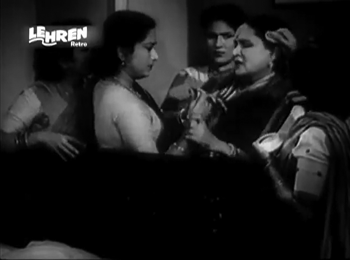 Another thing I appreciated about the film was the fact that the message is relatively subtle. Relationships work only when both parties make an effort to make them work. One person doing all the donkey work while the other(s) congratulate themselves on how grand everything is, leads to resentment. And relationships can be fragile, sensitive: a little thoughtlessness, a moment of derring-do, and you can ruin it. All of which is nothing new, as far as Hindi cinema is concerned—these are themes, after all, which form the basis of countless films—but I like the way Parivaar handles it: with humour and charm.
Another thing I appreciated about the film was the fact that the message is relatively subtle. Relationships work only when both parties make an effort to make them work. One person doing all the donkey work while the other(s) congratulate themselves on how grand everything is, leads to resentment. And relationships can be fragile, sensitive: a little thoughtlessness, a moment of derring-do, and you can ruin it. All of which is nothing new, as far as Hindi cinema is concerned—these are themes, after all, which form the basis of countless films—but I like the way Parivaar handles it: with humour and charm.
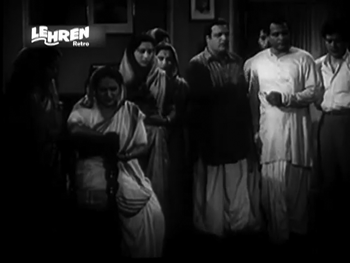
The music, by the inimitable Salil Choudhary, one of my favourites. Not all the songs are brilliant, but two stand out for me. One is the first song in the film, the lovely Jaa tose nahin boloon Kanhaiyya. The other is the beautiful Jhir-jhir, jhir-jhir badarwa barse. There’s an amusing item number, too, with Kishore Kumar (who also appears onscreen for this song): Kuvein mein koodke mar jaana, yaar tum shaadi na karna, in which the tune goes from a very Indian style to a peppy, obviously Western-influenced style.
What I didn’t like:
I would have preferred the initial sections to have been trimmed a bit—for instance, the scene where Dinesh is going about getting everybody in the house to climb onto the weighing scale so he can lecture them about controlling their weight. I thought several similar scenes, most of them thankfully quite short, in the first half of the film were superfluous; they didn’t even contribute much towards helping the audience get acquainted with the family.
A minor quibble, though. This is a film I’d recommend if you’re in the mood for something mellow and sweet and not star-studded.

Only know about the movie in the context of the Jhir Jhir Song. Seems to be a nice movie for a easy relaxed viewing. Thanks for the nice review.
LikeLike
You’ve hit the nail on the head – it does make for easy relaxed viewing. Thank you – glad you liked the review!
LikeLike
I stopped reading in between, because the film sounds so good. I want to watch the film. Not at all like what the title seems to suggest. I was wondering what Madhu was doing with a film having sucha name and had prepared myself for a satirical review and this turns out to be such a pleasant surprise.
Thank you for the review and bringing the film to my notice! :)
LikeLike
“I was wondering what Madhu was doing with a film having sucha name”
Yes, rather along the lines of Bhabhi, Chhoti Bahen, Khaandaan, Grahasti, Gharana etc, no? ;-) And all of them so terribly melodramatic and with so much rona-dhona. Seriously, I was not really looking forward to this film, but as soon as I saw it was a Bimal Roy production, I perked up. And it delivered. :-) Do watch it if you get the time, Harvey! It’s on Youtube.
LikeLike
I watched it and thoroughly enjoyed it.
Liked the ending as well (most part of it) giving concession to the age it was made in and all.
LikeLike
Oh, good! I’m glad you liked it, Harvey. Yes, given the period it was made in, I thought even the end was nice. Didn’t go overboard, even while it did have a message. Compared to all those AVM ‘family dramas’, this one was a refreshing change. :-)
LikeLike
Thanks for posting this review. This film (and Naukri) have been on my “to see” list. But I had put them off for a while since I expected a melodrama. “Jaa tose nahi bolooN kanhaiyya” is a favorite of mine and “Jhir jhir jhir jhir” is not far behind. But I had basically stopped at listening to the album and not progressed to the DVD. Based solely on your review, I am now going to find the time to watch it on youtube.
LikeLike
Do please watch it – it’s a really nice film, and even at its climax, never gets melodramatic. And the characters are all such likeable people. Even when they do silly things (as all of us end up doing now and then, in real life), it’s believable. I wish this film was better known for itself, not merely for those two superb songs.
Naukri had lovely songs too, didn’t it? If I remember correctly, Chhota sa ghar hoga badlon ki chhaaon mein is from that…? Haven’t seen the film, though…
LikeLike
That is the most popular song in Naukri. And I particularly love the slower version by Hemant Kumar, primarily cause I love his voice and since it is a rare song. There is also a Geeta solo in that film that is decent (a rare Geeta/Salil combo). I dont think the film is great based on what I have heard, but maybe i should give it a shot.
LikeLike
Oh, I hadn’t known there was a Hemant version of the song, too. I must look for it. I too love Hemant’s voice: there’s something so rich and unctuous and wonderful about it.
LikeLike
Thanks, Madhu. :-) I have wanted to watch this movie for a while – mainly for two songs – Jaa tose nahin boloon kanhaiyya and Jhir jhir jhir badarwa barse. But havent done so cos I was expecting lots of melodrama (going by the name). But your review makes me change my mind. Which is also a problem – cos there are too many movies in the “to watch” list.
LikeLike
Yes, these gharelu name movies invariably end up being hard to sit through! Bhabhi and Chhoti Bahen at least had good songs; Khaandaan couldn’t even boast of that. And all that melodrama and spiteful women and conspiring in-laws etc are too much! (By the way, never ever watch the Jeetendra-Nanda Parivaar. It’s horrible). But this one is a gem, a really sweet little film that I’d gladly watch again.
LikeLike
Oh…. why haven’t I watched this film yet? I remember it for Jhir jhir badarwa and Jaa tose nahin boloon, but I never knew it was a Bimal Roy/Asit Sen movie. (If I had, I might have watched it before.) This sounds sweet!
What I want to do is to go and watch it – now! – but I have two articles to write, several articles waiting for my tender, loving, editorial care, and half a deck full of snow to clear. :( You are bad, Madhu!)
LikeLike
Yes, I hadn’t known it was a Bimal Roy-Asit Sen film either; if I had, I’d have watched it a good deal earlier! Do watch, Anu. I think you’ll like it. The editing and writing can happen on the side (during the songs? ;-)) and the snow will melt. Eventually. :-D
LikeLike
Watched it, Madhu, and it is a sweet movie. Could have done without the ending being dragged on and on, but hey, that’s just a little thing. On the whole, it was really worth it. Thanks once again for writing it up.
LikeLike
I’m so glad you liked it, Anu! Yes, I think the end was a bit draggy – so was the first hour of the film, I thought – but on the whole, this was quite an enjoyable little film. :-)
LikeLike
Yes, the snow around here will melt in March, maybe :). Last year, I started watching this film on youtube basically for the same two reasons most others have wanted to, for the two wonderful songs. My premise was that there ought to be more nice songs from Salil Chowdhary in this movie that I had not heard. The print and sound was so bad, that I gave up plus the starting was so tediously slow. Now that I read that it is quite a nice one after all, I will look for a DVD or vcd. Thanks for the review.
LikeLike
Yes, the beginning is rather slow. I see Asit Sen’s point of view, in that he’s establishing the characters (and there are a lot of characters to establish!), but still: there are scenes there that could easily have been shortened or even cut out altogether. Do give it another try – it moves much faster in the second half, and turns out to be really quite sweet. I like the way the message(s) come across: subtle, not sledge-hammer.
LikeLike
I did watch it, thanks to Anu for a link to a pretty good print. Thoroughly enjoyed the movie. However I was amazed that in 1956, they are talking about calories, protein intake weight and exercise ( though it doesn’t stop them from frying up a batch of kachauries), jewellery catalogues and the term mortgage (which I did not hear in India). Sounds more like current times than 1956. The doctor’s wife was slim enough, the poor thing still had to jump rope 200 times. Wish they had shown the music conference they keep talking about and the couple winning rather than weighing everyone, I couldn’t help but smile at Durga Khote’s coyness when asked to step upon and her husband walks in. These looked like scenes from an era bygone but we have witnessed growing up in India. I wish there were more of great songs, but Salil Da gave us only 2 in this movie :(
Thanks for the review once again, enjoyed an old one after a long time.
LikeLike
“I couldn’t help but smile at Durga Khote’s coyness when asked to step upon and her husband walks in.” And I loved that scene where she’s lying in bed, all dolled up by her devranis, and her husband’s trying to coax her into telling him what’s wrong. Her answer is so cute!
Yes, I was also a little surprised by some of the concepts they talked about – those jewellery catalogues, the calories, etc. Actually, I was pleasantly surprised, and I thought it was rather realistic. Barring the eldest bhabhi, all the other women are educated, so it’s natural that even though they dress very traditionally and are – at first sight – fairly representative of Hindi film bahus, they also, thanks to their education, know of things like that. Reminds me, actually, of my own mother and her mother. My grandmother used to be a nurse before she got married (this was in the late 1930s), so stuff like this was not unknown to her.
LikeLike
Thank you all. I too read the review and used my afternoon off to watch the movie. Loved it….. My favorite line was Dhumal’s in the kitchen “sara din meeting meeting hota rahega to eating kab hoga?”.
LikeLike
Heh. Yes, that was a delightful line! The film was such an unusual one, as far as family dramas go. Not very dramatic, actually – more real than one often sees. A refreshing change.
P.S. Thank you for your comment on the post where I reviewed Gautam Chintamani’s book on Rajesh Khanna. I’ve stopped commenting there because it’s just such a pain trying to reason with people who refuse to accept that there can be views other than theirs – or that there is a civilised way of expressing a difference of opinion. But I just wanted to say thank you to you for being so rational.
LikeLike
This is really a sweet film. I know the word ‘sweet’ is often overused, ill-used or misused these days, but for this film, it is the most apt word. What i particularly like about this film is the way it focuses on the day-to-day small things in our households, which make life so interesting . It is a pity that this film is not so well known. At the time of its release too, it wasn’t a big success even though its bengali original ‘Ardhangini’ (1955) was a huge hit.
LikeLike
Ah, now I must look out for Ardhangini!
And I agree completely: Parivaar is a sweet film. There are very few films to which I’d apply that description, but if one deserves it, it’s this. So warm and everyday, so likeable.
LikeLike
Just few days ago watched this movie.I thought that it is going to be a movie with lots of melodrama,weeping and crying.What a coincidence same thing happend to me.While watching the credits I saw Bimal Roy and Asit Sen which assured that there is something good about this movie.
A very light hearted and a sweet movie with beautiful music.And definitely a well directed movie.I wish that famous artists would have worked in this movie.It must have been a blockbuster hit.
Yesterday night I watched Brahmachari.A very fine movie.Everything was awesome specially the songs and the acting of Shammi and Rajshree.I thought of reading your post after watching the movie without assuring that you made a post or not.I thought that u must have reviewed that movie (mainly because of two reasons) because you are diehard fan of Shammi Kapoor( me too) and because the movie was also good.You gave me a shock. I checked it twice thrice but nowhere I could see BRAHMACHARI.
Though an excellent post on Parivaar.Thankyou so much.
LikeLike
I agree, the name of this film makes it appear as if it might be one of those weepy melodramas of the type AVM Productions was famous for. But such a sweet, lovely little film – and yes, if it had had major stars in it, it could have been a big hit, I think.
Brahmachari is a film I’m somewhat conflicted about. I do know Shammi Kapoor won an award for it, and some of the songs are good (Aajkal tere-mere pyaar ke charche, especially), but somehow I’ve never been able to summon up as much of a love for that film as I have for several other Shammi films. I should watch it again sometime, perhaps…
LikeLike
Oh no problem.Its your personal choice,hope u didn’t mind.
LikeLike
No, of course not! Lots of people recommend films that may not be quite my cup of tea, but then, film appreciation (like appreciation of just about everything) is very subjective, so I am happy to respect other people’s opinions.
LikeLike